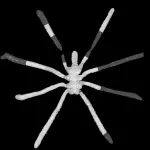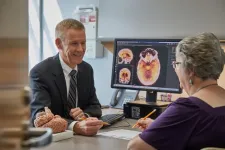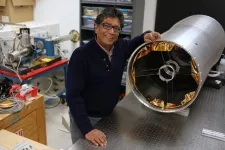(Press-News.org) An extremely rare collection of 160-million-year-old sea spider fossils from Southern France are closely related to living species, unlike older fossils of their kind.
These fossils are very important to understand the evolution of sea spiders. They show that the diversity of sea spiders that still exist today had already started to form by the Jurassic.
Lead author Dr Romain Sabroux from the University of Bristol’s School of Earth Sciences, said: “Sea spiders (Pycnogonida), are a group of marine animals that is overall very poorly studied.
“However, they are very interesting to understand the evolution of arthropods [the group that includes insects, arachnids, crustaceans, centipedes and millipedes] as they appeared relatively early in the arthropod tree of life. That’s why we are interested in their evolution.
“Sea spider fossils are very rare, but we know a few of them from different periods. One of the most remarkable fauna, by its diversity and its abundance, is the one of La Voulte-sur-Rhône that dates back to the Jurassic, some 160 million years ago.”
Unlike older sea spider fossils, the La Voulte pycnogonids are morphologically similar (but not identical) to living species, and previous studies suggested they could be closely related to living sea spider families. But these hypotheses were restricted by the limitation of their observation means. As it was impossible to access what was hidden in the rock fossils, Dr Sabroux and his team travelled to Paris and set out to investigate this question with cutting-edge approaches.
Dr Sabroux explained: “We used two methods to reinvestigate the morphology of the fossils: X-ray microtomography, to ‘look inside’ the rock, find morphological features hidden inside and reconstruct a 3D model of the fossilised specimen; and Reflectance Transformation Imaging, a picture technic that relies on varied orientation of the light around the fossil to enhance the visibility of inconspicuous features on their surface.
“From these new insights, we drew new morphological information to compare them with extant species,” explained Dr Sabroux.
This confirmed that these fossils are close relatives to surviving pycnogonids. Two of these fossils belong to two living pycnogonid families: Colossopantopodus boissinensis was a Colossendeidae while another, Palaeoendeis elmii was an Endeidae. The third species, Palaeopycnogonides gracilis, seems to belong to a family that has disappeared today.
“Today, by calculating the difference between the DNA sequences of a sample of species, and using DNA evolution models, we are able to estimate the timing of the evolution that bind these species together,“ added Dr Sabroux.
“This is what we call a molecular clock analysis. But quite like a real clock, it needs to be calibrated. Basically, we need to tell the clock: ‘we know that at that time, that group was already there.’ Thanks to our work, we now know that Colossendeidae, and Endeidae were already ’there’ by the Jurassic.”
Now, the team can use these minimal ages as calibrations for the molecular clock, and investigate the timing of Pycnogonida evolution. This can help them understand, for example, how their diversity was impacted by the different biodiversity crises that distributes over the Earth history.
They also plan to investigate other pycnogonid fossil faunae such as the fauna of Hunsrück Slate, in Germany, which dates from the Devonian, some 400 million years ago.
With the same approach, they will aim to redescribe these species and understand their affinities with extant species; and finally, to replace in the tree of life of Pycnogonida all the pycnogonid fossils from all periods.
Dr Sabroux added: “These fossils give us an insight of sea spiders living 160 million years ago.
“This is very exciting when you have been working on the living pycnogonids for years.
“It is fascinating how these pycnogonids look both very familiar, and very exotic. Familiar, because you can definitely recognize some of the families that still exist today, and exotic because of small differences like the size of the legs, the length of the body, and some other morphological characteristics that you do not find in modern species.
“Now we look forward to the next fossil discoveries - from the Jurassic and other geological periods - so that we can complete the picture!”
Paper:
‘New insights into the sea spider fauna (Arthropoda: Pycnogonida) of La Voulte-sur-Rhône, France (Jurassic: Callovian)’ by Romain Sabroux et al in Papers in Palaeontology.
END
The modern sea spider had started to diversify by the Jurassic, study finds
2023-08-17
ELSE PRESS RELEASES FROM THIS DATE:
MD Anderson receives nearly $4.9 million in CPRIT funding for cancer prevention programs and recruitment
2023-08-17
HOUSTON ― The University of Texas MD Anderson Cancer Center was awarded four grants totaling nearly $4.9 million from the Cancer Prevention and Research Institute of Texas (CPRIT) to support the expansion of physical activity programs for survivors, the dissemination of targeted tobacco cessation programs and the recruitment of a first-time, tenure-track faculty member.
MD Anderson’s Active Living After Cancer (ALAC) program received continued funding from CPRIT via two grants totaling $2,448,643 to ...
Real-time parking info now available through UTA Parking Finder app
2023-08-17
The University of Texas at Arlington has launched a new digital parking platform this fall that gives users real-time knowledge of available parking spaces, electric vehicle charging locations and garage/lot percentage occupancy.
The UTA Parking Finder is currently live and enables students, employees and visitors to make informed parking decisions in real time. Additional parking lot parking sensors will be added during the next three years until approximately 85% of all parking space on campus is covered.
The North Central Texas Council of Governments and Modii, a provider of modern mobility solutions, ...
Researchers unveil a new, economical approach for producing green hydrogen
2023-08-17
Researchers at the University of Colorado have developed a new and efficient way to produce green hydrogen or green syngas, a precursor to liquid fuels. The findings could open the door for more sustainable energy use in industries like transportation, steelmaking and ammonia production.
The new study, published Aug. 16 in the journal Joule, focuses on the production of hydrogen or syngas, a mixture of hydrogen and carbon monoxide that can be converted into fuels like gasoline, diesel and kerosene. The CU Boulder team lays the groundwork for what could be the first commercially viable method ...
Brown-led research provides unprecedented look at what influences sea ice motion in the Arctic
2023-08-16
PROVIDENCE, R.I. [Brown University] — A new study led by researchers at Brown offers fresh insights into the forces above and beneath the ocean surface that influence how sea ice moves and disperses in the Arctic Ocean, which is warming at over twice the rate of the global average.
The in-depth analysis reveals how local tidal currents strongly affect the movement of the ice along its journey and provides an unprecedented look at how the makeup of the seafloor is causing some of the most abrupt changes.
Data from the study can be applied to improve complex computer simulations used for forecasting Arctic sea ...
ORNL's Bryan Maldonado to receive 2023 HENAAC Most Promising Engineer Award
2023-08-16
Bryan Maldonado, a dynamic systems and controls researcher at the Department of Energy’s Oak Ridge National Laboratory, has been recognized by the 2023 Hispanic Engineer National Achievements Awards Conference, or HENAAC, with the Most Promising Engineer Award.
Given by Great Minds in STEM, or GMiS, the award highlights engineers who have made significant contributions to raising science, technology, engineering and math education awareness in underserved communities. Maldonado will receive ...
Several vaccines associated with reduced risk of Alzheimer’s disease in adults 65 and older
2023-08-16
Prior vaccination against tetanus and diphtheria, with or without pertussis (Tdap/Td); herpes zoster (HZ), better known as shingles; and pneumococcus are all associated with a reduced risk for developing Alzheimer’s disease, according to new research from UTHealth Houston.
A pre-press version of a study was published online recently in the Journal of Alzheimer’s Disease. It was led by co-first authors Kristofer Harris, program manager in the Department of Neurology with McGovern Medical School at UTHealth Houston; Yaobin Ling, graduate research assistant ...
The Global Flourishing Study launches open access of sample research data with the Center for Open Science
2023-08-16
Charlottesville, VA – The first sample dataset from the Global Flourishing Study (GFS) initiative is now available to researchers, with the project’s initial full dataset scheduled for release in the coming months through the Center for Open Science (COS).
The GFS, a partnership among Gallup, COS, and researchers at Baylor University and Harvard University, is a $43.4 million, five-year study of 200,000 individuals in 22 countries. The GFS data will be an open-access resource for researchers, journalists, policymakers, and ...
State-of-the-art UMass Lowell aerospace center seeded by $5.5M grant
2023-08-16
Drawing on UMass Lowell’s expertise in spacecraft design and track record of successful missions, the university has secured $5.5 million in state funding to launch a research center where scientists, industry leaders and startups can build and test miniature satellites and components essential to spaceflight.
The initiative, known as the Massachusetts Alliance for Space and Technology and Sciences, or MASTS, is anchored by a two-year, $5.5 million grant from the state via the Massachusetts ...
CCNY scientists trap light inside a magnet
2023-08-16
A new study led by Vinod M. Menon and his group at the City College of New York shows that trapping light inside magnetic materials may dramatically enhance their intrinsic properties. Strong optical responses of magnets are important for the development of magnetic lasers and magneto-optical memory devices, as well as for emerging quantum transduction applications.
In their new article in Nature, Menon and his team report the properties of a layered magnet that hosts strongly bound excitons -- quasiparticles with particularly strong optical interactions. Because of that, the material is capable of trapping light -- all by itself. As their experiments ...
Canadian researchers find radiation not necessary for patients with low-risk breast cancer
2023-08-16
HAMILTON, ON (August 16, 2023) – Some women with early-stage, low-risk breast cancer may not need radiotherapy after breast conserving surgery according to new research led by McMaster University, BC Cancer, Hamilton Heath Sciences, and the University of British Columbia.
The research, published in The New England Journal of Medicine on Aug. 17, shows women 55 or older with a specific subtype of Stage 1 breast cancer can be effectively treated with just surgery and endocrine therapy.
The ...











